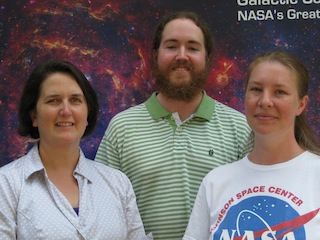
FAYETTEVILLE, Ark. — Physicists at the University of Arkansas will travel to the Kitt Peak National Observatory in November to observe growing black holes in the centers of nearby spiral galaxies.
The research team was awarded observing time the nights of Nov. 8-10 on the WIYN Telescope, the newest and second-largest telescope on Kitt Peak, part of the National Optical Astronomy Observatory near Tucson, Ariz.
“We will use the imaging to measure the pitch angle, or tightness, of their spiral arms and use existing spectra to estimate the masses of their central black holes,” said Julia Kennefick, an assistant professor of physics who is leading the project in collaboration with R. Scott Barrows, a recent University of Arkansas doctoral graduate.
“Our research group has recently found a relation between the central mass and the pitch angle of local spiral galaxies, and we want to see if this relation holds for more distant galaxies, too,” Kennefick said. “As we go further away, we are seeing galaxies as they were in the past, so this will give us some idea if the relation evolves with time.”
The information they gather at Kitt Peak will inform the research group’s investigation of galaxy structure and evolution, Kennefick said. Graduate students Benjamin Davis and Amanda Schilling will accompany Kennefick to Kitt Peak for the observations.
The research group includes four other physics professors across three campuses: Claud Lacy and Daniel Kennefick at the University of Arkansas, Marc Seigar at the University of Arkansas at Little Rock and Debra Burris at the University of Central Arkansas in Conway.
Julia and Daniel Kennefick and Claud Lacy have appointments in the Arkansas Center for Space and Planetary Sciences, an interdisciplinary research center at the U of A with 30 graduate students and nearly $3 million in awarded grants.
The trip is being funded by the space and planetary sciences center, the Raymond H. Hughes graduate program in physics in the university’s J. William Fulbright College of Arts and Sciences, the university’s office of vice provost for research and economic development and the National Optical Astronomy Observatory.
The WIYN Observatory is owned and operated by the WIYN Consortium, which consists of the University of Wisconsin, Indiana University, Yale University, and the National Optical Astronomy Observatory.
The National Optical Astronomy Observatory is the national research and development center for ground-based nighttime astronomy. Its core mission is to provide public access to qualified professional researchers via peer-review to forefront scientific capabilities on telescopes operated by the observatory.
Contacts
Julia Kennefick, assistant professor
physics
479-575-5916, jkennef@uark.edu
Chris Branam, research communications writer/editor
University Relations
479-575-4737,
cwbranam@uark.edu